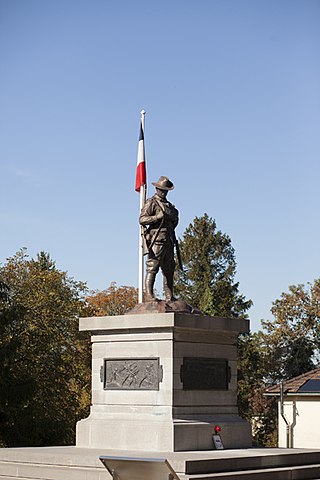Top Qs
Timeline
Chat
Perspective
Mont Saint-Quentin Australian war memorial
Australian war memorial From Wikipedia, the free encyclopedia
Remove ads
Mont Saint-Quentin Australian war memorial is an Australian First World War memorial located at Mont Saint-Quentin in Péronne, France. This monument was erected in honour of the fallen soldiers of the Australian Second Division during the Battle of Mont Saint-Quentin. It is one of five commemorative monuments initiated by the soldiers of the division. The memorial is located on the Bapaume-Péronne road (D1017).
Remove ads
Historical Background
The Battle of Mont Saint-Quentin was a part of the Allied Hundred Days Offensive. The Australian Corps crossed the Somme River on the night of 31 August 1918 and attacked the German lines at Mont Saint-Quentin. The position was only 100 meters high but was a key German defensive position because it overlooked the Somme River and served as an ideal observation post, and guarded the north and western approaches to Péronne.[1] The British Fourth Army's commander, General Henry Rawlinson, described the Australian advances of 31 August – 4 September as a great military achievement.[2] In three days the Australians endured 3,000 casualties but ensured a general German withdrawal eastwards back to the Hindenburg Line.[3]
Remove ads
Original memorial

The original monument consisted of a pedestaled sculpture, created by Charles Web Gilbert, representing an Australian soldier thrusting his bayonet into a German eagle. The pedestal has bronze bas-reliefs created by May Butler-George that depict soldiers in combat, namely men hauling and pushing a gun and men advancing with bayoneted rifles and hand grenades.[4] The memorial was inaugurated on August 30, 1925 and unveiled by Ferdinand Foch. In 1940, German soldiers destroyed the sculpture most probably due to the anti-German imagery.[5]
Remove ads
Present memorial
The plinth was not destroyed by German soldiers in 1940 and lay empty until 1971.[6] A replacement sculpture titled Digger by Australian sculptor Stanley James Hammond was erected in 1971.[4] The present-day sculpture is of a slouch-hatted Australian soldier with a slightly bowed head.[6] The pedestal still includes the bronze bas-reliefs created by May Butler-George.
See also
References
External links
Wikiwand - on
Seamless Wikipedia browsing. On steroids.
Remove ads


